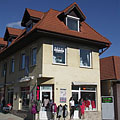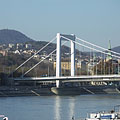(Optimalisert for enheter med liten skjerm)
Town center - Cegléd, Ungarn
Når du klikker:
Klikk på bildene!
-
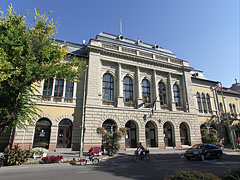
The eclectic style Town Hall of Cegléd
It was built in 1893, designed by Ágoston Márkus and Gyula Illés.
Dato for fotografering: 20062006
Laget av: Robert Németh
Kameramodell: Konica Minolta Dimage A200
Cegléd, Ungarn
-

The terrace of the Szindbád Restaurant and Wine Bar
Dato for fotografering: 04.07.20142014
Laget av: Robert Németh
Kameramodell: Konica Minolta Dimage A200
Cegléd, Ungarn
-

The main facade of the Kossuth Community Center, Cultural Center and Theater
It was built in 1927, originally the headquarters of the Cegléd Craftsmen's Union.
Dato for fotografering: 04.07.20142014
Laget av: Robert Németh
Kameramodell: Konica Minolta Dimage A200
Cegléd, Ungarn
-

The neo-gothic brick-walled tower of the Lutheran church of Cegléd
Dato for fotografering: 04.07.20142014
Laget av: Robert Németh
Kameramodell: Konica Minolta Dimage A200
Cegléd, Ungarn
-
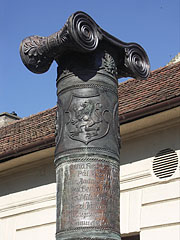
Memorial of the "100-person delegation to Turin"
Dato for fotografering: 04.07.20142014
Laget av: Robert Németh
Kameramodell: Konica Minolta Dimage A200
Cegléd, Ungarn
-
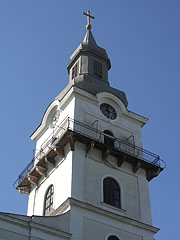
The Roman Catholic Holy Cross Parish Church
Dato for fotografering: 20062006
Laget av: Robert Németh
Kameramodell: Konica Minolta Dimage A200
Cegléd, Ungarn
-
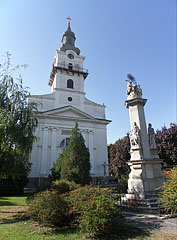
The neoclassical style Roman Catholic Parish Church
Built between 1822 and 1827, designed by Ferenc Homályosi Tunkel
Dato for fotografering: 20062006
Laget av: Robert Németh
Kameramodell: Konica Minolta Dimage A200
Cegléd, Ungarn
-
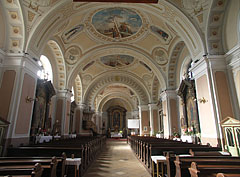
Interior of the Roman Catholic Parish Church (or Church of the Holy Cross, and sometimes called the "Old Church")
Dato for fotografering: 20062006
Laget av: Robert Németh
Kameramodell: Konica Minolta Dimage A200
Cegléd, Ungarn
-

Baroque Holy Trinity Column, and in the distance it is the TV tower
Dato for fotografering: 20062006
Laget av: Robert Németh
Kameramodell: Konica Minolta Dimage A200
Cegléd, Ungarn
-
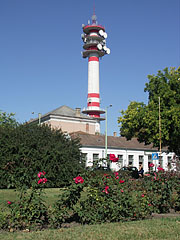
Rose bushes in the square, and the TV tower of Cegléd
Dato for fotografering: 20062006
Laget av: Robert Németh
Kameramodell: Konica Minolta Dimage A200
Cegléd, Ungarn
-
Television Tower (or TV tower)
Dato for fotografering: 20062006
Laget av: Robert Németh
Kameramodell: Konica Minolta Dimage A200
Cegléd, Ungarn
Television Tower (or TV tower) - Cegléd, Ungarn -
A brave cyclist on a high-wheeled velocipede (the ancestor of the bicycle), at the Roman Catholic church
Dato for fotografering: 20062006
Laget av: Robert Németh
Kameramodell: Konica Minolta Dimage A200
Cegléd, Ungarn
A brave cyclist on a high-wheeled velocipede (the ancestor of the bicycle), at the Roman Catholic church - Cegléd, Ungarn -
Cobblestoned small square with lamp posts and ornamental shrubs
Dato for fotografering: 20062006
Laget av: Robert Németh
Kameramodell: Konica Minolta Dimage A200
Cegléd, Ungarn
Cobblestoned small square with lamp posts and ornamental shrubs - Cegléd, Ungarn -
Red flowers in a stone vase
Dato for fotografering: 20062006
Laget av: Robert Németh
Kameramodell: Konica Minolta Dimage A200
Cegléd, Ungarn
Red flowers in a stone vase - Cegléd, Ungarn -
A statue and a stone flower vase in the square
Dato for fotografering: 20062006
Laget av: Robert Németh
Kameramodell: Konica Minolta Dimage A200
Cegléd, Ungarn
A statue and a stone flower vase in the square - Cegléd, Ungarn -
Statue of "the founders of the town", group of a nun, a citizen and a peasant girl
Work of Györgyi Lantos, 1989
Dato for fotografering: 20062006
Laget av: Robert Németh
Kameramodell: Konica Minolta Dimage A200
Cegléd, Ungarn
Statue of "the founders of the town", group of a nun, a citizen and a peasant girl - Cegléd, Ungarn -
Building of the Roman Catholic parish and the rectory
Dato for fotografering: 20062006
Laget av: Robert Németh
Kameramodell: Konica Minolta Dimage A200
Cegléd, Ungarn
Building of the Roman Catholic parish and the rectory - Cegléd, Ungarn -
Detail of the Town Hall, viewed from the Szabadság Square
Dato for fotografering: 20062006
Laget av: Robert Németh
Kameramodell: Konica Minolta Dimage A200
Cegléd, Ungarn
Detail of the Town Hall, viewed from the Szabadság Square - Cegléd, Ungarn -
Row of shops in the shadow of the trees
Dato for fotografering: 20062006
Laget av: Robert Németh
Kameramodell: Konica Minolta Dimage A200
Cegléd, Ungarn
Row of shops in the shadow of the trees - Cegléd, Ungarn -
György Dózsa memorial
The two-figure statue was created by József Somogyi in 1972.
Dato for fotografering: 20062006
Laget av: Robert Németh
Kameramodell: Konica Minolta Dimage A200
Cegléd, Ungarn
György Dózsa memorial - Cegléd, Ungarn -
Memorial of the Dózsa Rebellion behind the Roman Catholic church
The statue was created by József Somogyi in 1972.
Dato for fotografering: 20062006
Laget av: Robert Németh
Kameramodell: Konica Minolta Dimage A200
Cegléd, Ungarn
Memorial of the Dózsa Rebellion behind the Roman Catholic church - Cegléd, Ungarn -
The Roman Catholic Holy Cross Parish Church (in other name the "Old Church")
Dato for fotografering: 20062006
Laget av: Robert Németh
Kameramodell: Konica Minolta Dimage A200
Cegléd, Ungarn
The Roman Catholic Holy Cross Parish Church (in other name the "Old Church") - Cegléd, Ungarn -
Steeple (tower) of the Roman Catholic Old Church (officially the Holy Cross Parish Church)
Dato for fotografering: 20062006
Laget av: Robert Németh
Kameramodell: Konica Minolta Dimage A200
Cegléd, Ungarn
Steeple (tower) of the Roman Catholic Old Church (officially the Holy Cross Parish Church) - Cegléd, Ungarn -
Show-window of a shopping center
Dato for fotografering: 20062006
Laget av: Robert Németh
Kameramodell: Konica Minolta Dimage A200
Cegléd, Ungarn
Show-window of a shopping center - Cegléd, Ungarn -
Park atmosphere in the downtown area
Dato for fotografering: 20062006
Laget av: Robert Németh
Kameramodell: Konica Minolta Dimage A200
Cegléd, Ungarn
Park atmosphere in the downtown area - Cegléd, Ungarn -
The Calvinist (Reformed) Great Church
Dato for fotografering: 20062006
Laget av: Robert Németh
Kameramodell: Konica Minolta Dimage A200
Cegléd, Ungarn
The Calvinist (Reformed) Great Church - Cegléd, Ungarn -
Memorial of the "100-person delegation to Turin", a metal glazed pyro-granite statue with ionic column heads
Created by Gábor Varga and Pétel Pál Rontó in 2002.
Dato for fotografering: 20062006
Laget av: Robert Németh
Kameramodell: Konica Minolta Dimage A200
Cegléd, Ungarn
Memorial of the "100-person delegation to Turin", a metal glazed pyro-granite statue with ionic column heads - Cegléd, Ungarn -
The 53-meter-high steeple (tower) of the brick-built slender Lutheran Church
Dato for fotografering: 20062006
Laget av: Robert Németh
Kameramodell: Konica Minolta Dimage A200
Cegléd, Ungarn
The 53-meter-high steeple (tower) of the brick-built slender Lutheran Church - Cegléd, Ungarn -
The neogothic Lutheran Church
Built between 1895-1896, architect: Ottó Sztehlo
Dato for fotografering: 20062006
Laget av: Robert Németh
Kameramodell: Konica Minolta Dimage A200
Cegléd, Ungarn
The neogothic Lutheran Church - Cegléd, Ungarn -
The door of the Lutheran Church, with the motto of the lutherans: "Our God is a Mighty Fortress"
Dato for fotografering: 20062006
Laget av: Robert Németh
Kameramodell: Konica Minolta Dimage A200
Cegléd, Ungarn
The door of the Lutheran Church, with the motto of the lutherans: "Our God is a Mighty Fortress" - Cegléd, Ungarn -
The "Europe Tree" was planted in 2003
Dato for fotografering: 20062006
Laget av: Robert Németh
Kameramodell: Konica Minolta Dimage A200
Cegléd, Ungarn
The "Europe Tree" was planted in 2003 - Cegléd, Ungarn -
"Kossuth Tree" (it was planted in 2003)
Dato for fotografering: 20062006
Laget av: Robert Németh
Kameramodell: Konica Minolta Dimage A200
Cegléd, Ungarn
"Kossuth Tree" (it was planted in 2003) - Cegléd, Ungarn -
One of the towers of the Reformed Great Church ("Nagytemplom")
Dato for fotografering: 20062006
Laget av: Robert Németh
Kameramodell: Konica Minolta Dimage A200
Cegléd, Ungarn
One of the towers of the Reformed Great Church ("Nagytemplom") - Cegléd, Ungarn -
The steeples and the almost 61-meter-high dome of the Calvinist Great Church
Dato for fotografering: 20062006
Laget av: Robert Németh
Kameramodell: Konica Minolta Dimage A200
Cegléd, Ungarn
The steeples and the almost 61-meter-high dome of the Calvinist Great Church - Cegléd, Ungarn -
The Calvinist Great Church of Cegléd
Dato for fotografering: 20062006
Laget av: Robert Németh
Kameramodell: Konica Minolta Dimage A200
Cegléd, Ungarn
The Calvinist Great Church of Cegléd - Cegléd, Ungarn -
The Town Hall from Szabadság Square
Dato for fotografering: 20062006
Laget av: Robert Németh
Kameramodell: Konica Minolta Dimage A200
Cegléd, Ungarn
The Town Hall from Szabadság Square - Cegléd, Ungarn -
Kiosks, stands
Dato for fotografering: 20062006
Laget av: Robert Németh
Kameramodell: Konica Minolta Dimage A200
Cegléd, Ungarn
Kiosks, stands - Cegléd, Ungarn -
Eclectic style residental building from the late 19th century, with a "tower" and an enclosed balcony on its corner
Dato for fotografering: 20062006
Laget av: Robert Németh
Kameramodell: Konica Minolta Dimage A200
Cegléd, Ungarn
Eclectic style residental building from the late 19th century, with a "tower" and an enclosed balcony on its corner - Cegléd, Ungarn -
Shop entrance, above it there are renaissance ornaments on the enclosed balcony, and on the right it as the Lajos Kossuth memorial plaque
Dato for fotografering: 20062006
Laget av: Robert Németh
Kameramodell: Konica Minolta Dimage A200
Cegléd, Ungarn
Shop entrance, above it there are renaissance ornaments on the enclosed balcony, and on the right it as the Lajos Kossuth memorial plaque - Cegléd, Ungarn -
Kossuth memorial plaque
It was created by Ferenc Kéry in 1931, in memory of the recruiting speech of Lajos Kossuth Hungarian statesman here in 1848.
Dato for fotografering: 20062006
Laget av: Robert Németh
Kameramodell: Konica Minolta Dimage A200
Cegléd, Ungarn
Kossuth memorial plaque - Cegléd, Ungarn -
The classicist style Roman Catholic Parish Church
It was built between 1822-1827, architect: Ferenc Homályosi Tunkel
Dato for fotografering: 04.07.20142014
Laget av: Robert Németh
Kameramodell: Konica Minolta Dimage A200
Cegléd, Ungarn
The classicist style Roman Catholic Parish Church - Cegléd, Ungarn -
The steeple of the Roman Catholic Parish Church of Cegléd
Dato for fotografering: 04.07.20142014
Laget av: Robert Németh
Kameramodell: Konica Minolta Dimage A200
Cegléd, Ungarn
The steeple of the Roman Catholic Parish Church of Cegléd - Cegléd, Ungarn -
The terrace of the Szindbád Restaurant and Wine Bar
Dato for fotografering: 04.07.20142014
Laget av: Robert Németh
Kameramodell: Konica Minolta Dimage A200
Cegléd, Ungarn
The terrace of the Szindbád Restaurant and Wine Bar - Cegléd, Ungarn -
The Roman Catholic Parish Church of Cegléd, and a Holy Trinity column beside it
The Parish Church of Cegléd is officially called the Exaltation of the Holy Cross Parish Church, it was built in the 18th century.
Dato for fotografering: 04.07.20142014
Laget av: Robert Németh
Kameramodell: Konica Minolta Dimage A200
Cegléd, Ungarn
The Roman Catholic Parish Church of Cegléd, and a Holy Trinity column beside it - Cegléd, Ungarn -
Baroque style statues on the Holy Trinity column in front of the Roman Catholic church
As usual, these statues are the Father, the Son and the Holy Spirit, the latter is represented with a pigeon (these together constitute the so-called Holy Trinity).
Dato for fotografering: 04.07.20142014
Laget av: Robert Németh
Kameramodell: Konica Minolta Dimage A200
Cegléd, Ungarn
Baroque style statues on the Holy Trinity column in front of the Roman Catholic church - Cegléd, Ungarn -
Faith-Hope-Love, allegoric statues on the Holy Trinity column
The current column was created by György Kiss in 1902.
Dato for fotografering: 04.07.20142014
Laget av: Robert Németh
Kameramodell: Konica Minolta Dimage A200
Cegléd, Ungarn
Faith-Hope-Love, allegoric statues on the Holy Trinity column - Cegléd, Ungarn -
Town Court of Cegléd
Dato for fotografering: 04.07.20142014
Laget av: Robert Németh
Kameramodell: Konica Minolta Dimage A200
Cegléd, Ungarn
Town Court of Cegléd - Cegléd, Ungarn -
The eclectic style Town Court of Cegléd
Dato for fotografering: 04.07.20142014
Laget av: Robert Németh
Kameramodell: Konica Minolta Dimage A200
Cegléd, Ungarn
The eclectic style Town Court of Cegléd - Cegléd, Ungarn -
Stone statues of Minerva and Justitia over the entrance of the Town Court
Minerva and Justitia were the ancient Roman goddesses of the Wisdom and the Justice
Dato for fotografering: 04.07.20142014
Laget av: Robert Németh
Kameramodell: Konica Minolta Dimage A200
Cegléd, Ungarn
Stone statues of Minerva and Justitia over the entrance of the Town Court - Cegléd, Ungarn -
The coat of arms of Hungary (as well as the former Kingdom of Hungary) on the facade of the Cegléd Town Court
Dato for fotografering: 04.07.20142014
Laget av: Robert Németh
Kameramodell: Konica Minolta Dimage A200
Cegléd, Ungarn
The coat of arms of Hungary (as well as the former Kingdom of Hungary) on the facade of the Cegléd Town Court - Cegléd, Ungarn -
The high altar of the Roman Catholic church
Dato for fotografering: 04.07.20142014
Laget av: Robert Németh
Kameramodell: Konica Minolta Dimage A200
Cegléd, Ungarn
The high altar of the Roman Catholic church - Cegléd, Ungarn -
Interior of the Exaltation of the Holy Cross Roman Catholic Parish Church
Dato for fotografering: 04.07.20142014
Laget av: Robert Németh
Kameramodell: Konica Minolta Dimage A200
Cegléd, Ungarn
Interior of the Exaltation of the Holy Cross Roman Catholic Parish Church - Cegléd, Ungarn -
The pulpit of the Roman Catholic church
Dato for fotografering: 04.07.20142014
Laget av: Robert Németh
Kameramodell: Konica Minolta Dimage A200
Cegléd, Ungarn
The pulpit of the Roman Catholic church - Cegléd, Ungarn -
Statue of Saint Anthony of Padua in the Roman Catholic church
Dato for fotografering: 04.07.20142014
Laget av: Robert Németh
Kameramodell: Konica Minolta Dimage A200
Cegléd, Ungarn
Statue of Saint Anthony of Padua in the Roman Catholic church - Cegléd, Ungarn -
Statue of Mary Help of Christians (Virgin Mary) in the Roman Catholic church
Dato for fotografering: 04.07.20142014
Laget av: Robert Németh
Kameramodell: Konica Minolta Dimage A200
Cegléd, Ungarn
Statue of Mary Help of Christians (Virgin Mary) in the Roman Catholic church - Cegléd, Ungarn -
Ornate iron lattice in the Holy Cross Roman Catholic Parish Church
Dato for fotografering: 04.07.20142014
Laget av: Robert Németh
Kameramodell: Konica Minolta Dimage A200
Cegléd, Ungarn
Ornate iron lattice in the Holy Cross Roman Catholic Parish Church - Cegléd, Ungarn -
The Town Court and the TV tower behind it in the distance
Dato for fotografering: 04.07.20142014
Laget av: Robert Németh
Kameramodell: Konica Minolta Dimage A200
Cegléd, Ungarn
The Town Court and the TV tower behind it in the distance - Cegléd, Ungarn -
Town Court
Dato for fotografering: 04.07.20142014
Laget av: Robert Németh
Kameramodell: Konica Minolta Dimage A200
Cegléd, Ungarn
Town Court - Cegléd, Ungarn -
The TV tower of Cegléd
Dato for fotografering: 04.07.20142014
Laget av: Robert Németh
Kameramodell: Konica Minolta Dimage A200
Cegléd, Ungarn
The TV tower of Cegléd - Cegléd, Ungarn -
The main facade of the eclectic style Town Hall of Cegléd
Dato for fotografering: 04.07.20142014
Laget av: Robert Németh
Kameramodell: Konica Minolta Dimage A200
Cegléd, Ungarn
The main facade of the eclectic style Town Hall of Cegléd - Cegléd, Ungarn -
Town Hall of Cegléd, including the Mayor's Office and a Tourist Information Office (Tourinform)
Dato for fotografering: 04.07.20142014
Laget av: Robert Németh
Kameramodell: Konica Minolta Dimage A200
Cegléd, Ungarn
Town Hall of Cegléd, including the Mayor's Office and a Tourist Information Office (Tourinform) - Cegléd, Ungarn -
The two-story residental building from the late 19th century in front of the Town Hall
Dato for fotografering: 04.07.20142014
Laget av: Robert Németh
Kameramodell: Konica Minolta Dimage A200
Cegléd, Ungarn
The two-story residental building from the late 19th century in front of the Town Hall - Cegléd, Ungarn -
Two-storey eclectic building from the late 19th century, with a grocery shop on the ground floor
Dato for fotografering: 04.07.20142014
Laget av: Robert Németh
Kameramodell: Konica Minolta Dimage A200
Cegléd, Ungarn
Two-storey eclectic building from the late 19th century, with a grocery shop on the ground floor - Cegléd, Ungarn -
The vaulted shop-window with an ornate wrought iron grid on its top, on an older residental building
Dato for fotografering: 04.07.20142014
Laget av: Robert Németh
Kameramodell: Konica Minolta Dimage A200
Cegléd, Ungarn
The vaulted shop-window with an ornate wrought iron grid on its top, on an older residental building - Cegléd, Ungarn -
Two-story dwellinghouse with a nice closed balcony and a turret on its corner, facing the Town Hall, on the other side of the streat
Dato for fotografering: 04.07.20142014
Laget av: Robert Németh
Kameramodell: Konica Minolta Dimage A200
Cegléd, Ungarn
Two-story dwellinghouse with a nice closed balcony and a turret on its corner, facing the Town Hall, on the other side of the streat - Cegléd, Ungarn -
The old building of the Town Court at the edge of the park
Dato for fotografering: 04.07.20142014
Laget av: Robert Németh
Kameramodell: Konica Minolta Dimage A200
Cegléd, Ungarn
The old building of the Town Court at the edge of the park - Cegléd, Ungarn -
Two-storey eclectic corner building from the late 19th century, with a grocery shop, an art school and a restaurant inside it
Dato for fotografering: 04.07.20142014
Laget av: Robert Németh
Kameramodell: Konica Minolta Dimage A200
Cegléd, Ungarn
Two-storey eclectic corner building from the late 19th century, with a grocery shop, an art school and a restaurant inside it - Cegléd, Ungarn -
Two-storey eclectic style residental building, including a CBA grocery store, the District Prosecutor Office and the so-called Pi Theater (Patkós Irma Secondary School of Arts)
Dato for fotografering: 04.07.20142014
Laget av: Robert Németh
Kameramodell: Konica Minolta Dimage A200
Cegléd, Ungarn
Two-storey eclectic style residental building, including a CBA grocery store, the District Prosecutor Office and the so-called Pi Theater (Patkós Irma Secondary School of Arts) - Cegléd, Ungarn -
The terrace of the Arizóna Pizzeria and Hamburgeria, and a sales stand beside it
Dato for fotografering: 04.07.20142014
Laget av: Robert Németh
Kameramodell: Konica Minolta Dimage A200
Cegléd, Ungarn
The terrace of the Arizóna Pizzeria and Hamburgeria, and a sales stand beside it - Cegléd, Ungarn -
Tables on the terrace of the Arizóna Pizzeria and Hamburgeria
Dato for fotografering: 04.07.20142014
Laget av: Robert Németh
Kameramodell: Konica Minolta Dimage A200
Cegléd, Ungarn
Tables on the terrace of the Arizóna Pizzeria and Hamburgeria - Cegléd, Ungarn -
Greengrocer's shop (fruit and vegetable shop)
Dato for fotografering: 04.07.20142014
Laget av: Robert Németh
Kameramodell: Konica Minolta Dimage A200
Cegléd, Ungarn
Greengrocer's shop (fruit and vegetable shop) - Cegléd, Ungarn -
Bright yellow painted one-story listed building, with the Kelopátra jewellery and goldsmith's workshop inside it, since 2002
Dato for fotografering: 04.07.20142014
Laget av: Robert Németh
Kameramodell: Konica Minolta Dimage A200
Cegléd, Ungarn
Bright yellow painted one-story listed building, with the Kelopátra jewellery and goldsmith's workshop inside it, since 2002 - Cegléd, Ungarn -
Kelopátra jewellery and goldsmith's workshop
Dato for fotografering: 04.07.20142014
Laget av: Robert Németh
Kameramodell: Konica Minolta Dimage A200
Cegléd, Ungarn
Kelopátra jewellery and goldsmith's workshop - Cegléd, Ungarn -
Decorations on the facade of the jewelry shop
Dato for fotografering: 04.07.20142014
Laget av: Robert Németh
Kameramodell: Konica Minolta Dimage A200
Cegléd, Ungarn
Decorations on the facade of the jewelry shop - Cegléd, Ungarn -
Kossuth Community Center and Theater
Dato for fotografering: 04.07.20142014
Laget av: Robert Németh
Kameramodell: Konica Minolta Dimage A200
Cegléd, Ungarn
Kossuth Community Center and Theater - Cegléd, Ungarn -
Kossuth Community Centre and Theatre, also including the Cegléd Gallery exhibition hall
Dato for fotografering: 04.07.20142014
Laget av: Robert Németh
Kameramodell: Konica Minolta Dimage A200
Cegléd, Ungarn
Kossuth Community Centre and Theatre, also including the Cegléd Gallery exhibition hall - Cegléd, Ungarn -
Rose garden at the Dávia department store
Dato for fotografering: 04.07.20142014
Laget av: Robert Németh
Kameramodell: Konica Minolta Dimage A200
Cegléd, Ungarn
Rose garden at the Dávia department store - Cegléd, Ungarn -
A relief representing books and a torch in a laurel wreath, on the facade of the Kossuth Community Centre and Theatre
Dato for fotografering: 04.07.20142014
Laget av: Robert Németh
Kameramodell: Konica Minolta Dimage A200
Cegléd, Ungarn
A relief representing books and a torch in a laurel wreath, on the facade of the Kossuth Community Centre and Theatre - Cegléd, Ungarn -
The main facade of the Kossuth Community Center and Theater
Dato for fotografering: 04.07.20142014
Laget av: Robert Németh
Kameramodell: Konica Minolta Dimage A200
Cegléd, Ungarn
The main facade of the Kossuth Community Center and Theater - Cegléd, Ungarn -
Relief decoration on the wall of the Kossuth Community Center and Theater
Dato for fotografering: 04.07.20142014
Laget av: Robert Németh
Kameramodell: Konica Minolta Dimage A200
Cegléd, Ungarn
Relief decoration on the wall of the Kossuth Community Center and Theater - Cegléd, Ungarn -
The main entrance of the Kossuth Community Center and Theater
Dato for fotografering: 04.07.20142014
Laget av: Robert Németh
Kameramodell: Konica Minolta Dimage A200
Cegléd, Ungarn
The main entrance of the Kossuth Community Center and Theater - Cegléd, Ungarn -
The main entrance of the Kossuth Community Center and Theater
Dato for fotografering: 04.07.20142014
Laget av: Robert Németh
Kameramodell: Konica Minolta Dimage A200
Cegléd, Ungarn
The main entrance of the Kossuth Community Center and Theater - Cegléd, Ungarn -
Dávia Üzletház (department store)
The building was designed by János Márkus and originally it was called Opál Üzletház (department store).
Dato for fotografering: 04.07.20142014
Laget av: Robert Németh
Kameramodell: Konica Minolta Dimage A200
Cegléd, Ungarn
Dávia Üzletház (department store) - Cegléd, Ungarn -
Street view at the Town Hall
Dato for fotografering: 04.07.20142014
Laget av: Robert Németh
Kameramodell: Konica Minolta Dimage A200
Cegléd, Ungarn
Street view at the Town Hall - Cegléd, Ungarn -
The houses of the main square and the Calvinist Great Church, viewed from the Town Hall of Cegléd
Dato for fotografering: 04.07.20142014
Laget av: Robert Németh
Kameramodell: Konica Minolta Dimage A200
Cegléd, Ungarn
The houses of the main square and the Calvinist Great Church, viewed from the Town Hall of Cegléd - Cegléd, Ungarn -
The Calvinist Great Church of Cegléd
Dato for fotografering: 04.07.20142014
Laget av: Robert Németh
Kameramodell: Konica Minolta Dimage A200
Cegléd, Ungarn
The Calvinist Great Church of Cegléd - Cegléd, Ungarn -
Late romantic style two-story residental building with a small balcony with wrought iron railing, and a dental center on its ground floor
The house was built around 1870
Dato for fotografering: 04.07.20142014
Laget av: Robert Németh
Kameramodell: Konica Minolta Dimage A200
Cegléd, Ungarn
Late romantic style two-story residental building with a small balcony with wrought iron railing, and a dental center on its ground floor - Cegléd, Ungarn -
The one-storey building of the Generali Insurance Company, immediately next to the Reformed Great Church
Dato for fotografering: 04.07.20142014
Laget av: Robert Németh
Kameramodell: Konica Minolta Dimage A200
Cegléd, Ungarn
The one-storey building of the Generali Insurance Company, immediately next to the Reformed Great Church - Cegléd, Ungarn -
Statue of Lajos Kossuth in the park
The sculptor János Horvay created the two supporting figures supposedly based on real people from Cegléd (the elder man was called Sámuel Lédeczi).
Dato for fotografering: 04.07.20142014
Laget av: Robert Németh
Kameramodell: Konica Minolta Dimage A200
Cegléd, Ungarn
Statue of Lajos Kossuth in the park - Cegléd, Ungarn -
Statue of Lajos Kossuth 19th-century Hungarian governor and reformist politician in the park
Created by János Horvay in 1902, the Kossuth statue in New York was created in 1928 based on this one.
Dato for fotografering: 04.07.20142014
Laget av: Robert Németh
Kameramodell: Konica Minolta Dimage A200
Cegléd, Ungarn
Statue of Lajos Kossuth 19th-century Hungarian governor and reformist politician in the park - Cegléd, Ungarn -
The 60-meter-tall dome of the Calvinist (Reformed) Great Church of Cegléd
The current dome was built many decades after the church itself in 1938, architect: Frigyes Benedek.
Dato for fotografering: 04.07.20142014
Laget av: Robert Németh
Kameramodell: Konica Minolta Dimage A200
Cegléd, Ungarn
The 60-meter-tall dome of the Calvinist (Reformed) Great Church of Cegléd - Cegléd, Ungarn -
One of the belltowers of the Calvinist Great Church
Dato for fotografering: 04.07.20142014
Laget av: Robert Németh
Kameramodell: Konica Minolta Dimage A200
Cegléd, Ungarn
One of the belltowers of the Calvinist Great Church - Cegléd, Ungarn -
Calvinist (Reformed) Great Church of Cegléd
Dato for fotografering: 04.07.20142014
Laget av: Robert Németh
Kameramodell: Konica Minolta Dimage A200
Cegléd, Ungarn
Calvinist (Reformed) Great Church of Cegléd - Cegléd, Ungarn -
The main facade of the classicist style Calvinist (Reformed) Great Church of Cegléd
Dato for fotografering: 04.07.20142014
Laget av: Robert Németh
Kameramodell: Konica Minolta Dimage A200
Cegléd, Ungarn
The main facade of the classicist style Calvinist (Reformed) Great Church of Cegléd - Cegléd, Ungarn -
The main facade and the entrance of the Calvinist (Reformed) Great Church of Cegléd
Dato for fotografering: 04.07.20142014
Laget av: Robert Németh
Kameramodell: Konica Minolta Dimage A200
Cegléd, Ungarn
The main facade and the entrance of the Calvinist (Reformed) Great Church of Cegléd - Cegléd, Ungarn -
Portico (columned porch) a spandrel or tympanum supported by four ionic columns on the main facade of the Calvinist Great Church
Dato for fotografering: 04.07.20142014
Laget av: Robert Németh
Kameramodell: Konica Minolta Dimage A200
Cegléd, Ungarn
Portico (columned porch) a spandrel or tympanum supported by four ionic columns on the main facade of the Calvinist Great Church - Cegléd, Ungarn -
Memorial column of the "100-person delegation to Turin"
Created by Gábor Varga and Péter Pál Rontó in 2002.
Dato for fotografering: 04.07.20142014
Laget av: Robert Németh
Kameramodell: Konica Minolta Dimage A200
Cegléd, Ungarn
Memorial column of the "100-person delegation to Turin" - Cegléd, Ungarn -
Concrete flower boxes on the street in front of the Calvinist church
Dato for fotografering: 04.07.20142014
Laget av: Robert Németh
Kameramodell: Konica Minolta Dimage A200
Cegléd, Ungarn
Concrete flower boxes on the street in front of the Calvinist church - Cegléd, Ungarn -
The main door of the Calvinist (Reformed) Great Church of Cegléd
Dato for fotografering: 04.07.20142014
Laget av: Robert Németh
Kameramodell: Konica Minolta Dimage A200
Cegléd, Ungarn
The main door of the Calvinist (Reformed) Great Church of Cegléd - Cegléd, Ungarn -
Wood carved memorial column, a Trianon memorial headboard at the fence of the reformed church
Dato for fotografering: 04.07.20142014
Laget av: Robert Németh
Kameramodell: Konica Minolta Dimage A200
Cegléd, Ungarn
Wood carved memorial column, a Trianon memorial headboard at the fence of the reformed church - Cegléd, Ungarn -
Carved wooden column in the garden of the Calvinist Great Church, next to the fence (it is a Trianon memorial)
Dato for fotografering: 04.07.20142014
Laget av: Robert Németh
Kameramodell: Konica Minolta Dimage A200
Cegléd, Ungarn
Carved wooden column in the garden of the Calvinist Great Church, next to the fence (it is a Trianon memorial) - Cegléd, Ungarn -
The garden of the Calvinist Great Church
Dato for fotografering: 04.07.20142014
Laget av: Robert Németh
Kameramodell: Konica Minolta Dimage A200
Cegléd, Ungarn
The garden of the Calvinist Great Church - Cegléd, Ungarn -
The garden of the Calvinist (Reformed) Great Church
Dato for fotografering: 04.07.20142014
Laget av: Robert Németh
Kameramodell: Konica Minolta Dimage A200
Cegléd, Ungarn
The garden of the Calvinist (Reformed) Great Church - Cegléd, Ungarn -
The wrought iron fence of the Reformed (Calvinist) Great Church
Dato for fotografering: 04.07.20142014
Laget av: Robert Németh
Kameramodell: Konica Minolta Dimage A200
Cegléd, Ungarn
The wrought iron fence of the Reformed (Calvinist) Great Church - Cegléd, Ungarn -
Colorful petunia flowers in the park near the Calvinist Great Church
Dato for fotografering: 04.07.20142014
Laget av: Robert Németh
Kameramodell: Konica Minolta Dimage A200
Cegléd, Ungarn
Colorful petunia flowers in the park near the Calvinist Great Church - Cegléd, Ungarn -
Colorful petunia flowers at the Calvinist Church
Dato for fotografering: 04.07.20142014
Laget av: Robert Németh
Kameramodell: Konica Minolta Dimage A200
Cegléd, Ungarn
Colorful petunia flowers at the Calvinist Church - Cegléd, Ungarn -
Calvinist Primary School
The school was founded in 1545.
Dato for fotografering: 04.07.20142014
Laget av: Robert Németh
Kameramodell: Konica Minolta Dimage A200
Cegléd, Ungarn
Calvinist Primary School - Cegléd, Ungarn -
Calvinist (Reformed) Primary School
Dato for fotografering: 04.07.20142014
Laget av: Robert Németh
Kameramodell: Konica Minolta Dimage A200
Cegléd, Ungarn
Calvinist (Reformed) Primary School - Cegléd, Ungarn -
Park Büfé snack bar and ice cream parlor in the former bazaar building
Dato for fotografering: 04.07.20142014
Laget av: Robert Németh
Kameramodell: Konica Minolta Dimage A200
Cegléd, Ungarn
Park Büfé snack bar and ice cream parlor in the former bazaar building - Cegléd, Ungarn -
The neo-gothic style Lutheran (Evangelical) church of Cegléd
Dato for fotografering: 04.07.20142014
Laget av: Robert Németh
Kameramodell: Konica Minolta Dimage A200
Cegléd, Ungarn
The neo-gothic style Lutheran (Evangelical) church of Cegléd - Cegléd, Ungarn -
The slender steeple of the Lutheran church of Cegléd
Dato for fotografering: 04.07.20142014
Laget av: Robert Németh
Kameramodell: Konica Minolta Dimage A200
Cegléd, Ungarn
The slender steeple of the Lutheran church of Cegléd - Cegléd, Ungarn -
The rear side of the neo-gothic style Lutheran church of Cegléd
It was built in 1896, desined by architect Ottó Sztehlo from Budapest.
Dato for fotografering: 04.07.20142014
Laget av: Robert Németh
Kameramodell: Konica Minolta Dimage A200
Cegléd, Ungarn
The rear side of the neo-gothic style Lutheran church of Cegléd - Cegléd, Ungarn -
The area behinf the Lutheran church of Cegléd
Dato for fotografering: 04.07.20142014
Laget av: Robert Németh
Kameramodell: Konica Minolta Dimage A200
Cegléd, Ungarn
The area behinf the Lutheran church of Cegléd - Cegléd, Ungarn -
A garage door and a green creeper plant on the wall, behind the Lutheran church
Dato for fotografering: 04.07.20142014
Laget av: Robert Németh
Kameramodell: Konica Minolta Dimage A200
Cegléd, Ungarn
A garage door and a green creeper plant on the wall, behind the Lutheran church - Cegléd, Ungarn -
A doorway near the Lutheran church
Dato for fotografering: 04.07.20142014
Laget av: Robert Németh
Kameramodell: Konica Minolta Dimage A200
Cegléd, Ungarn
A doorway near the Lutheran church - Cegléd, Ungarn -
Former bazaar building bear the Lutheran church, now it includes the Municipal Library
The church and the bazaar was built together in 1896.
Dato for fotografering: 04.07.20142014
Laget av: Robert Németh
Kameramodell: Konica Minolta Dimage A200
Cegléd, Ungarn
Former bazaar building bear the Lutheran church, now it includes the Municipal Library - Cegléd, Ungarn -
Park in the main square with roses and a lot of trees
Dato for fotografering: 04.07.20142014
Laget av: Robert Németh
Kameramodell: Konica Minolta Dimage A200
Cegléd, Ungarn
Park in the main square with roses and a lot of trees - Cegléd, Ungarn -
The covered bazaar and the Calvinist (Reformed) Primary School
Dato for fotografering: 04.07.20142014
Laget av: Robert Németh
Kameramodell: Konica Minolta Dimage A200
Cegléd, Ungarn
The covered bazaar and the Calvinist (Reformed) Primary School - Cegléd, Ungarn -
The "Kossuth Tree" plane tree in the park
It was planted in 2003, in honor of Lajos Kossuth 19th-century Hungarian politician.
Dato for fotografering: 04.07.20142014
Laget av: Robert Németh
Kameramodell: Konica Minolta Dimage A200
Cegléd, Ungarn
The "Kossuth Tree" plane tree in the park - Cegléd, Ungarn -
The plate of the "Kossuth Tree"
Dato for fotografering: 04.07.20142014
Laget av: Robert Németh
Kameramodell: Konica Minolta Dimage A200
Cegléd, Ungarn
The plate of the "Kossuth Tree" - Cegléd, Ungarn -
Statue of Lajos Kossuth 19th-century Hungarian politician in the park
Dato for fotografering: 04.07.20142014
Laget av: Robert Németh
Kameramodell: Konica Minolta Dimage A200
Cegléd, Ungarn
Statue of Lajos Kossuth 19th-century Hungarian politician in the park - Cegléd, Ungarn -
Ornamental stone urn on the facade of the Calvinist Great Church, on the top of the triangular tympanum
Dato for fotografering: 04.07.20142014
Laget av: Robert Németh
Kameramodell: Konica Minolta Dimage A200
Cegléd, Ungarn
Ornamental stone urn on the facade of the Calvinist Great Church, on the top of the triangular tympanum - Cegléd, Ungarn -
One of the towers of the Calvinist Great Church of Cegléd
Dato for fotografering: 04.07.20142014
Laget av: Robert Németh
Kameramodell: Konica Minolta Dimage A200
Cegléd, Ungarn
One of the towers of the Calvinist Great Church of Cegléd - Cegléd, Ungarn -
Shady park
Dato for fotografering: 04.07.20142014
Laget av: Robert Németh
Kameramodell: Konica Minolta Dimage A200
Cegléd, Ungarn
Shady park - Cegléd, Ungarn -
Row of houses on the main square, and the Calvinist Great Church
Dato for fotografering: 04.07.20142014
Laget av: Robert Németh
Kameramodell: Konica Minolta Dimage A200
Cegléd, Ungarn
Row of houses on the main square, and the Calvinist Great Church - Cegléd, Ungarn
Klikk på bildene!
Egenskaper
Plassering:
GPS-Koordinaten: For tiden ikke tilgjengelig
Informasjon, korte historier, interessante fakta
 Statue of "the founders of the town", group of a nun, a citizen and a peasant girl
Statue of "the founders of the town", group of a nun, a citizen and a peasant girl
Work of Györgyi Lantos, 1989
The history of Cegléd town was started with King Louis I of Hungary (also known as Louis the Great), when in 1358 he donated this royal estate to his mother Elizabeth of Poland (Elżbieta Łokietkówna), who passed it to the nuns of Óbuda. The nun character in the three-figure statue group of the Hungarian sculptor Györgyi Lantos in the Eötvös Square refers to this event. The statue is called "Town Founders" and it was inaugurated in 1989.
The area was already inhabited much earlier, in the Copper Age and then also in the Bronze Age. Later it was a temporary home of Iranian descent nomad tribes, first Scythians then in the Roman times nomadic Sarmatians. The emergence of a permanent settlement was begun in the age of the Árpád dynasty (the Arpads or Árpádians), immediately after the Hungarian conquest of the Carpathian Basin at the end of the 9th century (in Hungarian simply "Honfoglalás"). After the Mongol invasion in Hungary (between 1241-1242) the country accommodated escaping heathen kun people, who settled probably also around Cegléd.
The first written record of the settlement (as "Chegled") is from 1290, but this is not a clear evidence for this town in the Great Plain, because at that time there were more settlement with this name. The first credible source about the existence of Cegléd was a charter from 1358, which was about the mentioned donation. 10 years later Elizabeth of Poland gave the estate to the Clarissan nuns. They are the "Poor Clares", members of the Order of Saint Clare, which is the female branch of the men's Roman Catholic Franciscan Order, founded by Saint Clare of Assisi and Saint Francis of Assisi. From then the strict and rigorous Clarissa nuns were the feudal lords of Cegléd until 1782, except during the Ottoman rule. Among other things with their high taxes they practically push the citizens of Cegléd from the Roman Catholic fate towards the Reformation (Protestantism).
 Memorial of the Dózsa Rebellion behind the Roman Catholic church
Memorial of the Dózsa Rebellion behind the Roman Catholic church
The statue was created by József Somogyi in 1972.
The Dózsa Rebellion in 1514 was evolved from a planned crusade against the Ottoman Empire. The military leader of this campaign would be György Dózsa, who then became the leader of the peasant army as well. Due to many reasons the crusade was cancelled, and the recruited serfs and peasants rebelled against their lords and the whole nobility. The rebellion could be suppressed only after four months, and it was followed by the retorsions. Many tens of thousands of peasants were tortured, although there were executions mostly just among the leaders of the revolt. It happened like this probably just because the nobles still needed the peasant labor force.
 Calvinist (Reformed) Great Church of Cegléd
Calvinist (Reformed) Great Church of Cegléd
The building of the monumental Calvinist (Reformed) Great Church was begun by the neoclassical style plans of József Hild in 1835. The construction was fairly slow, and in addition the Hungarian Revolution and Independence War of 1848-1849 was also intervened. The Reformed pastor and the Catholic priest together went into battle against the oppressive Austrians, but after the fall of the revolution they were imprisoned so the building of the church delayed even further. Finally it was managed to finish in 1871, but due to lack of funds in a much simplier form: the bell-towers had tympanum endings with simple pyramidal spires, and on the place of the dome there was just a low-pitched pyramidal roof. The towers received their current hemispherical shape with the roof lanterns in the year of the Hungarian Millenium (1896) by the plans of Ernő Balázs. At that time a dome was also built, including a so-called tambour (also known as tholobate or drum), a circular or cylindrical wall pierced with windows in a circle, which carried the spherical cap-shaped dome roof. However, this version was still disproportionately low compared to the towers. The shapeful, well-proportioned hemispherical dome that can be seen today was built of copper plate covered ferro-concrete, designed by Figyes Benedek and it was completed in 1938.
 Memorial of the "100-person delegation to Turin"
Memorial of the "100-person delegation to Turin"
In 1877 Cegléd town invited Lajos Kossuth to be their National Assembly representative (parliamentarian). At that time the politician was lived in Turin (Torino) in Italy, hundred citizens of Cegléd town travelled to there the convince him. Although Lajos Kossuth had to reject the offer, later at the turn of the 19th-20th centuries his son Ferenc Kossuth was already the representative of the town in the Parliament. To commemorate the travel of the formerly sent hundred delegates their descendants founded an alliance (it was called in Hungarian "Turini Százas Küldöttség Múzeumbaráti Kör", approximately "The 100-person Turin Delegation Club of the Museum Friends"), then they established the current Kossuth Museum.
Du kan også være interessert i (Relaterte sider):
Destinasjoner i reiseguide:
Cegléd (125 bilder + 2 panorama bilder)
Pest megye (county) (15 122 bilder + 50 panorama bilder)
Budapest og dens omkringliggende (15 989 bilder + 52 panorama bilder)
Ungarn (27 287 bilder + 163 panorama bilder)
og i tillegg:
(innenfor her: Pest megye)
Pilis Mountains (Pilis hegység) (335 bilder)
Buda Hills (Budai-hegység) (8 632 bilder + 21 panorama bilder)
Gödöllő Hills (Gödöllői-dombság) (4 203 bilder + 21 panorama bilder)
Ráckeve (92 bilder)
Dunakeszi (259 bilder)
Göd (23 bilder)
Nagykőrös (250 bilder + 2 panorama bilder)
Nagymaros (31 bilder)
Pilisvörösvár (88 bilder)
Szentendre (597 bilder + 1 panorama bilder)
Vác (232 bilder + 2 panorama bilder)
Visegrád (220 bilder + 1 panorama bilder)
Csővár (105 bilder)
Kóspallag (53 bilder)
Márianosztra (37 bilder)
Nagybörzsöny (4 bilder)
Pilisszentkereszt (122 bilder)
Zsámbék
Alle panoramabilde her:
Cegléd (2 bilder)
Pest megye (county) (50 bilder)
Budapest og dens omkringliggende (52 bilder)
Ungarn (163 bilder)
Europa (165 bilder)
Hver normal bilde her:
Cegléd (125 bilder)
Pest megye (county) (15 122 bilder / 221 gallerier)
Budapest og dens omkringliggende (15 989 bilder / 234 gallerier)
Ungarn (27 287 bilder / 462 gallerier)
Europa (30 494 bilder / 523 gallerier)
https://www.panadea.com/no/guidebook/cegled/photos/gal-001

Legg til i Favoritter Legg til Bokmerker
Del med vennene dine!
osv.
Om oss - Generelle forbehold -
Alle rettigheter reservert
- ©2010-2022
Neuronit Creative Studio - Mogyoród / Budapest / Ungarn


